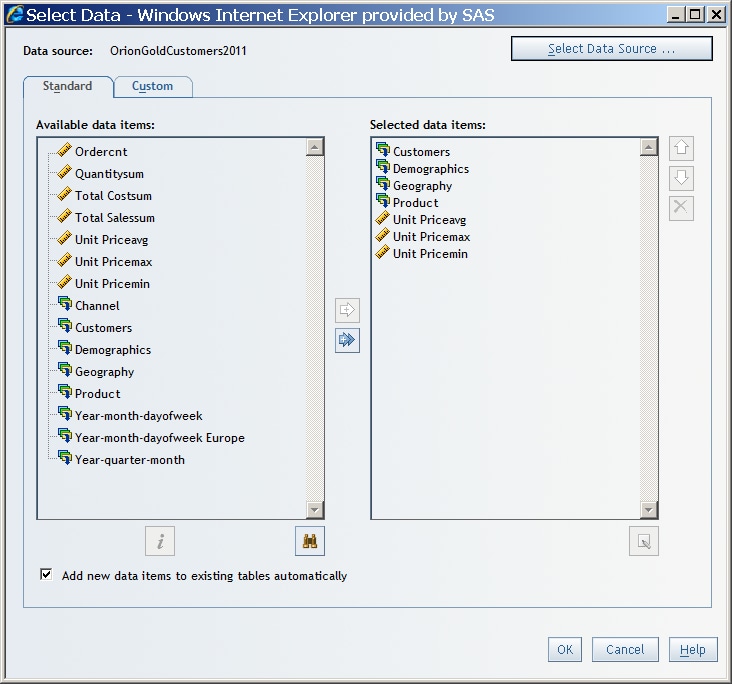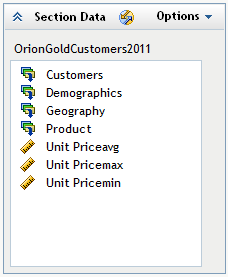Using Standard Data Items in a Query
About Standard Data Items
Each data source includes
one or more standard data items. You decide which data items to use
to define a query for a report section. You can use all the data items
in the data source or a subset of data items. Each standard data item
is classified as either a category, a hierarchy, or a measure.
Category 

A data item whose distinct
values are used to group and aggregate measures. There are four types
of categories: alphanumeric, date, timestamp, and time. Alphanumeric
categories can be made up of all letters, all digits, or a combination
of the two. Categories that have values that are all digits might
be physically stored as character or numeric data. The data type affects
how values are handled in relation to some functionality, such as
filtering, sorting, and formatting.
Measure 

Hierarchy 

An arrangement of the
levels in a dimension from general to specific. The first level in
the hierarchy is the root level.
For example, a common
dimension in a multidimensional data source is
Time.
A dimension that is named Time might
have a hierarchy named YrQtrMth. Such
a hierarchy might enable you to look at data for each Year (the
root level), drill down to see the data for each Quarter (second
level) in a specific year, and then drill down to see the data for
the three Months (third level) that
make up a particular quarter.
Select Standard Data Items
To select the standard
data items that you want to use in the query for the current report
section, complete these steps:
-
In the Available data items list box, select one or more data items, and then click
 to move them to the Selected data items list
box. This adds the data item or items to the query. Some users will
be able to move all data items in the data source by clicking
to move them to the Selected data items list
box. This adds the data item or items to the query. Some users will
be able to move all data items in the data source by clicking  .
Select Data Dialog Box Showing Four Categories and Three Measures Selected from a Multidimensional Data Source
.
Select Data Dialog Box Showing Four Categories and Three Measures Selected from a Multidimensional Data Source Note: To view the data type and description for a data item, select a single data item in the Available data items list box, and then click
Note: To view the data type and description for a data item, select a single data item in the Available data items list box, and then click .
Note: For relational data sources, you can select the same measure multiple times, rename each instance of the measure (see step 7), and apply a different aggregation to each instance of the measure (see Modify How a Measure Is Aggregated).
.
Note: For relational data sources, you can select the same measure multiple times, rename each instance of the measure (see step 7), and apply a different aggregation to each instance of the measure (see Modify How a Measure Is Aggregated). -
(Optional) Clear the Add new data items to existing tables automatically check box if you do not want new data items automatically added to existing tables. (Adding new data items to tables might affect existing filters, percent of total calculations, and conditional highlighting.) If you clear this check box, then new data items that are added to the Selected data items list box are hidden from existing tables. If you want to move a hidden data item to a row or a column in an existing table, then use the Assign Data dialog box to make that change.For existing crosstabulation tables that have at least one category assigned to Columns, additional data items are assigned to the Rows function. If you add measures, the additional measures are assigned to whatever function the current measures are assigned to. That is, if measures are currently assigned to Rows, then the additional measures are also assigned to Rows. For list tables, if this option is selected, new data items are added to the Columns function.

